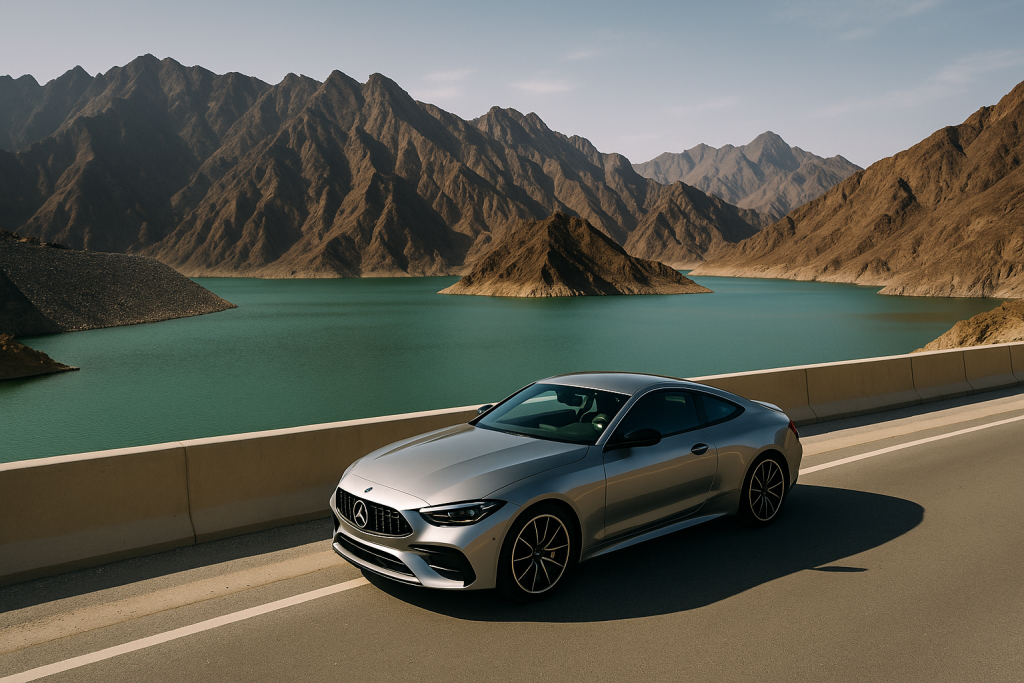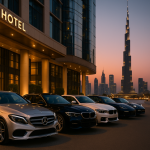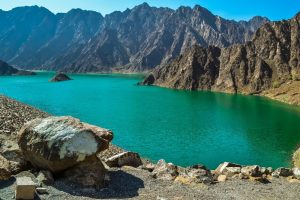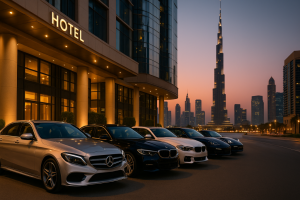From Dubai to Hatta: route for a sports coupe
At alligator.rent, we offer not just car rental – we offer the opportunity to evaluate the vehicle outside the city. The route from Dubai to Hatta, passing through the mountainous area and the Hatta dam, is one such example.
Route details
Hatta is an enclave of the emirate of Dubai, located in the foothills of the hajar mountains. The trip from Dubai there involves first crossing a desert area and then gradually moving into a hilly and mountainous zone.
The main connecting section is the e44 highway, which connects Dubai with Hatta and is used by most routes heading toward the mountain area. On the map, the road is marked as the Dubai-Hatta highway. E44 consists of segments that connect urban traffic with remote zones, and in some places, the road is interrupted (for example, through a section controlled by a border regime) and then resumes closer to Hatta.
There are also alternative options, for example, highways connecting sharjah and kalba, which can be used to bypass the most congested areas.
The distance from Dubai to Hatta is approximately 110-130 kilometers, depending on the starting point in the city and the chosen route. The travel time is approximately one and a half hours, assuming moderate traffic and no long stops.
The surface quality on highway e44 is mostly high, featuring smooth asphalt, sufficient lane width, and clear lane markings. In the mountains and closer to Hatta, the road becomes more winding; there may be small elevation changes and sections with technical wear, but overall it remains suitable for sports cars with a careful driving style.
Enjoy every mile — rent a sport car in Dubai.
Route stages and road features
The route can be divided into several logically different parts:
- Urban and suburban segment
The first 20-30 km pass through the urban or suburban area of Dubai. Traffic intensity is high, with frequent intersections with highways, exits, and traffic lights. Driving on this section requires concentration and caution. - Desert segment along e44 highway
After leaving the urban area, there is a straight section where the road runs through desert spaces with minimal turns. Here, it is possible to maintain a stable speed. - Transition to the foothill zone
The road gradually begins to rise; gentle curves and elevation changes appear. The surface remains in good condition, but more elements appear that require attention: turns, retaining walls, and shoulders. - Serpentine sections near Hatta
At the final stage, the road becomes winding. Turns alternate with more straight segments; there are slopes and inclined sections. Here, the car’s qualities are revealed: stability, steering response, and braking behavior. - Section along the Hatta dam
At the final stage, the road runs near the reservoir formed by the dam, which changes the configuration of the road: curves along the shore, potential viewpoints, and shoulders. Stopping and slow driving are possible here.
Stop points, cafes, viewing platforms
Throughout the route, the number of suitable stopping points is limited, especially outside the urban area. Therefore, it is important to plan rest stops in advance.
- On highway e44, within the urban zone, there are gas stations, service stations, and cafes – it is recommended to use them before entering the remote area.
- In the foothills, closer to Hatta, there are small areas where short stops on the shoulder are possible – for checking tires, resting, or brief inspections.
- Approaching the Hatta dam, there are places where the road lies closer to the water and the shoulders are slightly wider – you can safely stop there and perform a technical check.
- In Hatta itself, there are cafes and restaurants designed for visitors arriving by road, especially around the center and the water area. These places are convenient for lunch or rest before the return trip.
- Hatta also has viewing platforms, watchtowers, and a historical village, which can serve as destinations for stops, though they are not always located directly on the highway – small detours are possible.
Trip cost, expenses, and organization
When using our sports coupe rental offer, the client bears the following expenses:
- Rental fee – the base cost of the coupe model for the selected period.
- Fuel – the route to and from, including possible deviations, can total 220-260 km; with a coupe consumption of 12-15 l/100 km under load, about 26-40 liters will be required.
- Deposit – a standard practice when renting sports cars.
- Mileage limits – exceeding the allowed mileage may result in fines.
- Stops and meals – cafes and restaurants at final and intermediate points, depending on the route deviations.
- Extra charges for overload or driving outside permitted roads – fines are possible if the car is taken onto roads outside the main route or unsuitable for coupes.
When planning the trip, clients should consider fuel reserves, a backup maintenance plan, and plan stops so as not to exceed the limits.
Which coupe models are suitable
Not all sports coupes are equally suitable for routes with mountain sections. To ensure the trip goes smoothly, the model must meet a number of characteristics:
- Handling – precise steering, minimal body roll on turns.
- Braking system with reserve capacity – long descents require efficient brakes, preferably ventilated and with a cooling system.
- Power reserve and torque – sufficient traction is needed on climbs, preferably available in the mid-range rpm.
- Ground clearance and undercarriage protection – to minimize the risk of damage on uneven sections or small surface defects.
- Engine and oil cooling system – engine overheating is most likely during prolonged uphill driving under load.
- Drive type – rear-wheel drive coupes are acceptable, but in turns and complex configurations, all-wheel drive may have an advantage.
From our fleet, the most suitable models are those specially equipped with sport packages: reinforced brakes, sport suspension, and improved cooling systems. Models with low-profile tires and minimal ground clearance should be used with particular caution, avoiding sections with potholes or uneven surfaces.
Feel the breeze, the freedom, the delight — rent convertible today.
Departure time and optimal schedule
To let you test the car in comfortable conditions, the start and return times matter:
- Morning departure – the most comfortable: before intense city traffic, cooler for the engine and tires.
- Weekdays are preferable – on weekends, the tourist flow increases, especially in Hatta and on the ascent road.
- Return before darkness – mountain sections are poorly lit; it is better to complete the route in daylight.
- Avoid rush hours – in the morning (around 7:30-9:30 a.m.) And evening (4:00-7:00 p.m.) – as movement in Dubai and at highway entrances can slow down significantly.
With this approach, the client will get optimal time use and the best test experience of the car.
Driving technique tips
- When entering a turn – reduce speed in advance; do not brake sharply during the turn.
- On descents, use a low gear (engine braking) to reduce brake load.
- Avoid sharp trajectory changes on narrow sections.
- Monitor engine and oil temperature – the load is higher in hot weather.
- Avoid wheel spin on unpaved or sandy sections – especially if the road is partly covered with fine sand.
- When stopping near water or the dam, pay attention to shoulders and surface stability.
Route advantages
- You can test the car under a mix of straight and winding sections.
- It provides a variety of road conditions: flat sections, climbs, descents, and a road along the water.
- Important coupe characteristics are revealed – brakes, stability, steering response.
- Possibility of stops at viewing points and the dam for technical checks.
Vehicle risks
- Possible engine and brake overheating under long loads.
- Areas with sand or small gravel in the mountains.
- Narrow sections where maneuvering is limited.
- Lack of lighting on road sections after sunset.
- Exceeding mileage limits or violating rental conditions.
- Risk of underbody damage on uneven surfaces.
Example route plan
- Departure from Dubai around 6:30-7:00 a.m.
- Exit onto highway e44 or through an alternative route.
- Drive straight, then prepare for the foothills.
- Transition to the winding section, evaluate handling.
- Stop near Hatta dam – inspection, rest, photos.
- Enter Hatta, visit the heritage village or viewing points.
- Lunch at a local café.
- Return along the more direct e44 highway to minimize travel time.
- Return to Dubai before dark, avoiding rush hour.
The route from Dubai to Hatta through the dam and mountains provides the best road for a sports coupe test drive: a combination of straight sections, climbs, turns, and specific road features.








